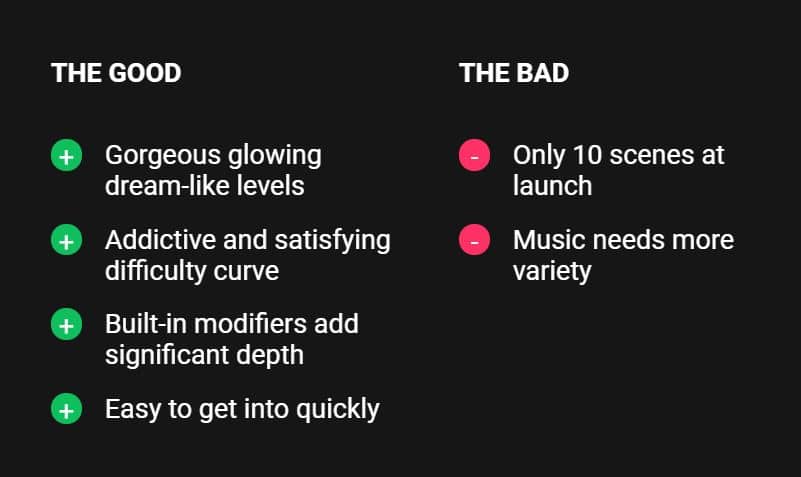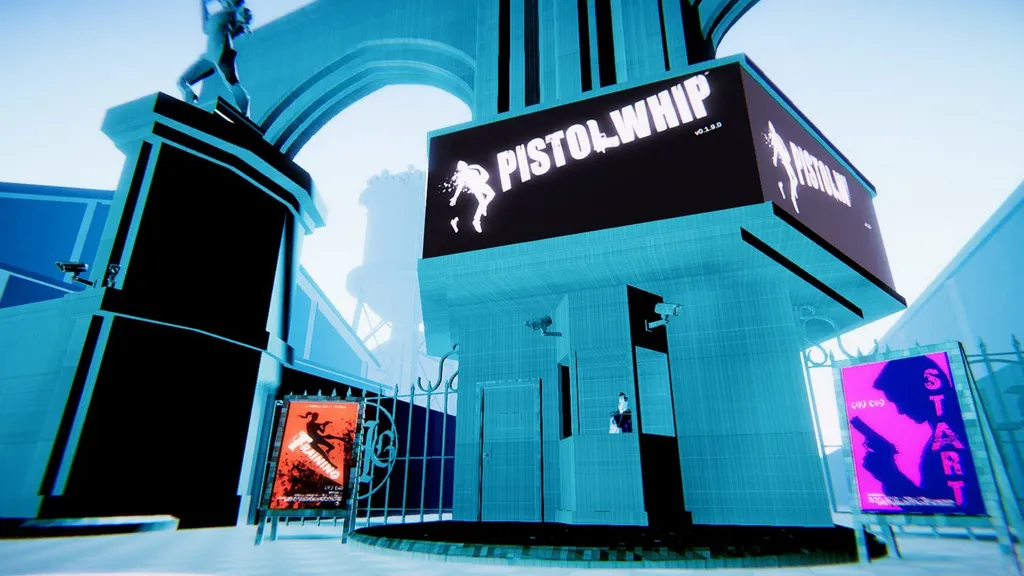My first words to Cloudhead CEO Denny Unger after playing an early version of Pistol Whip: “Holy $&#%”. After dozens of hours in the game that still sums up my overall impression.
A standard Pistol Whip play session for me is at least half an hour with my knees bent for agility and moving closer to the beat each time through a song. I’ll feel an adrenaline rush gaining proficiency and matching the tempo of my shots only to be killed by a bullet I know is coming. I’ll grit my teeth in frustration at my own stupid head for not moving out of the way quicker, and go again and again — typically until l beat the level or wipe away the sweat and take a breather.
You can look at Pistol Whip and see so many other VR titles influencing it. Even if Pistol Whip wears the rhythm of Beat Saber and art style of Superhot on its stylish sleeves, Cloudhead’s new game moves VR design forward in its own ways. Rather than slashing cubes or simply avoiding bullets in slow-motion, every song (or scene) in Pistol Whip moves you through the level at a steady pace. Enemies pop out at pre-determined locations that you then must shoot or punch to the beat of the music to get the highest score possible.
Difficulty Options
I count around half a dozen difficulty-altering options Pistol Whip players can try to find their groove. There are separate scoreboards for Oculus and Steam players and, though many people probably won’t play this way, if you get hooked on maximizing score there’s enough challenge and skill required in Deadeye mode for potentially endless play.
More scenes (both free and paid) are planned by developer Cloudhead Games, with the 10 included available in easy, normal and hard flavors. The main mode of Pistol Whip is built around an aim assistance feature that makes most players feel like an expert shooter. Most people are not a John Wick-level marksman and the built-in modifiers will prove it — just turn Deadeye on with the built-in menu and feel the crushing difficulty of perfectly lining up sights and timing shots just right.
If this is too hard, players can activate the Dual-wield mode to add a second gun and riddle the colorful simulation with bullets.
Pistol Whip Skill Progression
Each Pistol Whip song included at launch is licensed from Kannibalen Records and roughly three to five minutes long. You can pick any of the ten at the start of the game, and any difficulty. One shot takes out enemies with no armor, a bulletproof vest takes one more, or a motorcycle helmet combined with full body armor requires four shots total to defeat.
I’d expect many players who are familiar with VR, and shooters, to try the normal difficulty at first and find their way through some tracks after maybe a few attempts. Some players — those unfamiliar with games and VR in general, or those looking for a more relaxed session — can use the training and start with the easy version of the scenes.
Select the hard version of a scene and the number of enemies increases as does the number of bullets needed to take many of them down. Some of the songs at this difficulty could take some players dozens of tries to get through. David Jagneaux played five of the songs over more than an hour on stream and he didn’t complete one on hard. In his defense, he spent that time touring through some of the game’s built-in modifiers, answering questions from viewers, and generally not building the memory of a track which is critical to completing one. I’ve beaten all the scenes on hard — I spent many hours doing so — and moved onto Deadeye mode to try and improve my aim.
This is the only song I’ve beaten so far in that mode:
The important bit here is that there are multiple levels of challenge for each of the included scenes, and multiple styles of play it can serve. This should allow a wide range of players — from a shooter-savvy marksman to a first-time VR buyer — to find entry points where they can start searching for Pistol Whip’s groove.
Dancing Through A Gunfight
There are so many power fantasy action movies that come to mind moving forward through Pistol Whip’s glowing fever dream maps. The one which I think best describes the nirvana power fantasy feeling of playing it is Edge Of Tomorrow. That’s the Tom Cruise versus aliens movie where he gets a power that lets him — Live. Die. Repeat. — essentially fighting seemingly unwinnable battles over and over again and marginally improving over time.
Pistol Whip teaches you to read the environment looking for platforms where enemies may spawn moments before they actually do, to listen close to the gunfire and know exactly when, and from which direction, the bullets are coming. This training, hard-earned from repeated playthroughs, teaches players when to duck, lean or move out of the way just in time to save themselves. Proficiency at Pistol Whip means moving with the rhythm and that’s just about the time it starts looking and feeling more like dancing.
Below is a video for the same scene and difficulty level as above but this time I turn Deadeye mode off and, because I’ve memorized the map, I play in a much more relaxed style where aim isn’t as important.
Does it get boring?

If you’re not a fan of Pistol Whip’s included music there’s no support for custom maps at launch, so don’t expect to play a level inspired by 8 Mile’s Lose Yourself, or whatever your dream song is, for some time.
I find most of the songs pretty enjoyable but definitely take a listen to the videos on this page and see if there’s a fit with your tastes before committing to a purchase. I find the songs that aren’t my favorites can still be fun because the level designs come with enough surprises to make them challenging in slightly different ways.
On Revelations you’ve got to regularly slip your head between narrow crevices while on Download The Future some of the enemies send bullets from far away long before you can reply. That means you’ve got several more seconds to get out of the way of a wave of bullets while more enemies ready up to fire closer to you.
Death is my favorite of the launch scenes with its more than 5-minute battle playing out like you’re being chased through a Day of The Dead festival colored by yellows, oranges and reds on a hot day, then, after about a minute, the lyric “I’ll bring you death!” marks the transition to a cool kind of afterlife marked with purples and pinks as the walkway changes to a long narrow path over the abyss.
Mileage with Pistol Whip will definitely vary from mine, which amounts to roughly 50 hours with no end in sight. The main motivation here is dodge the bullet or die. If you complete all 10 songs on hard quickly, don’t like a few of the songs enough not to play their scene, or don’t find the Deadeye and/or Dual-wield modes to be a fun challenge, you’re going to spend a fraction of the time with this game compared to me.
Violence
Pistol Whip artificially moves the player forward through its scenes in a straight line at a constant rate of speed. While nowhere near the most uncomfortable type of simulated movement VR software might employ, it is possible some players might feel a little woozy or uncomfortable. VR’s current rhythm leader Beat Saber, in contrast, moves boxes past a stationary player that should be more comfortable to a wider selection of players. Still, I am one of the most sensitive people on staff to simulator sickness and experienced not even a hint of it in Pistol Whip with a Valve Index or Oculus Quest.
Even if you get a couple hours of fun out of Pistol Whip that’s — let’s be honest — more than most VR games get out of most players, and practically none of that time wearing the headset is spent learning made-for-VR mechanics like teleportation or grasping simulated objects. No, in Pistol Whip you point the gun, pull the trigger, shake it up and down to reload and remember to dodge incoming bullets by moving your head out of the way. That’s it. That’s the entire game and, for me, each of these scenes and the Deadeye modifier makes for an addictive challenge that pays off again and again and again.
Pistol Whip Platform Differences
The wireless freedom of Quest can make it easier to move with the kind of speed and confidence required, to, say, jump into the air to dodge a bullet and then bring your gun down on a bad guy’s head in a single movement. On Index it’s a gorgeous trip with a smoothness to everything — and a depth to the sound — that’s missed in the Oculus Quest. As noted above there are separate leaderboards for Oculus and Steam buyers.
Comfort
Despite the age warnings associated with many headsets kids often play VR games and there are some differences between Pistol Whip and Beat Saber which parents or guardians should bear in mind. Beat Saber hands players a simulated tool inspired by a fictional laser sword from a long time ago in a galaxy far far away, and its “enemies” are boxes. Pistol Whip’s tool is a gun and its enemies take the shape of people. So I would recommend taking to heart a lyric in one of Pistol Whip’s songs: “Due to some violent content, parental discretion is advised.”

Pistol Whip Review Verdict:
Pistol Whip’s multiple difficulties and modifiers like Deadeye and Dual-wield add depth to a game that’s more addictive and satisfying than Beat Saber. This is neither fully a shooter nor completely a rhythm game yet it ticks off both boxes and does so exceptionally quickly in a stylish package. The 10 launch songs, all in the same general musical style, are a bit limiting. Pistol Whip, though, is already the game that brings me back to my VR headset again and again, and I expect that to be the case for months to come. I’ll be in the group waiting for more official scenes to arrive, trying to finish a few more songs in Deadeye mode on hard, showing the game to others and hoping someone figures out how to add custom maps and songs.
Final Score: 



 5/5 Stars | Fantastic
5/5 Stars | Fantastic

You can read more about our five-star scoring policy here.
Pistol Whip releases today and will be available on Steam for PC VR headsets, Oculus Home for Rift, and Oculus Home for Quest.


























